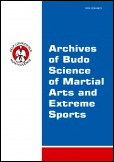2018, Volume 14, Issue 1
Development of the ability to maintain body balance in young athletes 12-13 years practicing judo
Aleksander Yurievich Osipov1, Mikhail Dmitrievich Kudryavtsev2, Sergii Sidorovich Iermakov3, Władysław Jagiełło4, Sergey Anatolevich Doroshenko5
1Department of Physical Culture, Department of Valeology, Siberian Federal University | Department of Physical Culture, Krasnoyarsk State Medical University named after professor V.F. Voyno-Yasenetsky | Department of Physical Training, Siberian law Institu, Krasnoyarsk, Russia
2Department of Physical Culture, Department of Valeology, Siberian Federal University | Department of Physical Education, Reshetnev Siberian State University of Science and Technology | Department of Physical Training, Siberian law Institute of the Ministr, Krasnoyarsk, Russia
3Department of Tourism and Recreation, Gdansk University of Physical Education and Sport, Gdansk, Poland
4Department of Physical Education, Gdansk University of Physical Education and Sport, Gdansk, Poland
5Department of Physical Culture, Department of Valeology, Siberian Federal University, Krasnoyarsk, Russia
Author for correspondence: Władysław Jagiełło; Department of Physical Education, Gdansk University of Physical Education and Sport, Gdansk, Poland; email: wjagiello1@wp.pl
Full text
Abstract
Background & Study Aim: Preservation of postural stability of the body during competitive fights is considered an important factor in achieving success in judo. It is believed that the indicators of maintaining the balance of the body is much higher in adults and experienced athletes. The aim of this study is the knowledge the possibility of increasing the body balance of young athletes practicing judo through modification of training sessions.
Material & Methods: The contingent studied 30 young athletes practicing judo. Age of athletes of 12-13 years. Experience judo 1.5-2 years. The duration of the research is 1 year. To increase the body balance of athletes in static and dynamic conditions, specially selected exercises were used. The athletes of the experimental group (n = 15) performed these exercises in each training session (at least 30 minutes). Athletes of the control group (n = 15) used these exercises irregularly and in a smaller volume. To assess the level of body balance of athletes used tests: Hirtz's test, "flamingo balance test”, “stork balance stand test” (Alpha-Fit version), "modified bass test of dynamic balance", a motor test with somersaults, the implementation of technology uchi-mata and o-uchi-gari. To determine the ability to maintain a stable equilibrium, the stabiloplatform – "Stabilan 01-2" (production of "OKB RITM", Russia) was used. The level of competitive activity of athletes was estimated by the method of analysis of video recordings of competitive matches. Evaluation of the test results was performed using Mann-Whitney U-test.
Results: At the end of the study period, a significant (p<0.01) advantage of athletes of the experimental group was revealed in a number of tests that determine the dynamic balance of the body. The highest differences were found in the data of" Flamingo balance test"," Target " test, motor test with somersaults. The results of tests that allow to assess the static balance of the body, did not reveal a significant advantage of athletes of any group. The positive influence of the purposeful training of balance of a body of athletes on speed of performance by judo athletes of complex coordination throws (uchi-mata and o-uchi-gari) is revealed. Comparative analysis of the level of competitive activity of athletes did not reveal a significant relationship between the indicators of the balance of the body and the activity of judo athletes aged 12-13 in competitive matches.
Conclusions: The use of specially selected exercises can significantly increase the body balance of young athletes practicing judo. High body balance indicators allow athletes to have a significant advantage over their peers in the speed of performing some complex coordination shots (uchi-mata and o-uchi-gari) and resistance to dynamic effects.
Key words: competitive activity, Hirtz\'s test, judo sessions, modified bass test of dynamic balance, throwing technique





